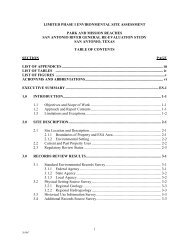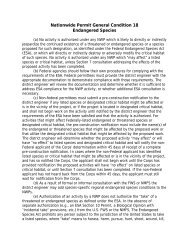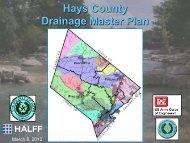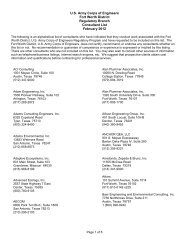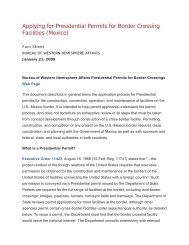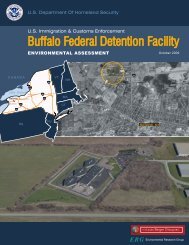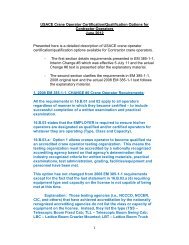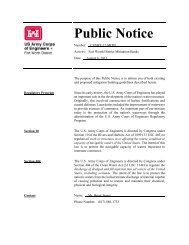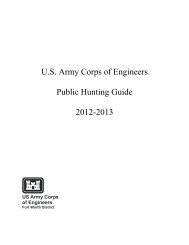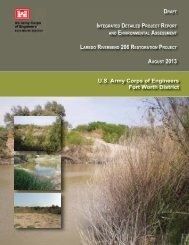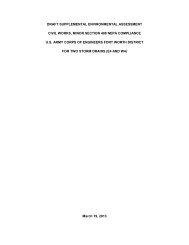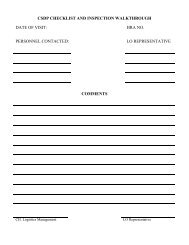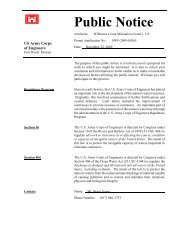environmental assessment us border patrol, tucson sector
environmental assessment us border patrol, tucson sector
environmental assessment us border patrol, tucson sector
Create successful ePaper yourself
Turn your PDF publications into a flip-book with our unique Google optimized e-Paper software.
3-41234567891011121314151617181920212223242526272829303132333435363738394041424344454647zoning for the area and surrounding land <strong>us</strong>e. Therefore, impacts on land <strong>us</strong>e from Alternative 4would be negligible.3.3 SOILS3.3.1 Affected EnvironmentCochise County is in southeast Arizona, and <strong>border</strong>s New Mexico to the east and Mexico to thesouth. Cochise County is located entirely within the Basin and Range Province and ischaracterized by gently sloping plains broken by rugged mountain ranges. The mountain rangesin southeastern Cochise County are generally aligned in a north-south direction, and define theboundaries of the San Bernardino Valley (Perilla, Pedragosa, and Chiricahua mountain ranges tothe west and the Peloncillo Mountains to the east). Soils in the San Bernardino Valley arederived from a mix of alluvium materials from surrounding mountain ranges, including basalt,cinders, bombs, and volcanic rocks.3.3.1.1 Preferred AlternativeThe Preferred Alternative site is currently unoccupied, vacant land and is entirely underlain bythe Eloma sandy loam, 1 to 10 percent slopes (Figure 3-1; NRCS 2011). This alluvial soil isderived from a mixed fan alluvium parent material and is characterized by gravelly loam,gravelly clay, and gravelly sandy clay loam. This soil is well-drained, has low to moderate wateravailability, and a low to medium runoff rate.3.3.1.2 Alternative 2The Alternative 2 site is unoccupied, vacant land underlain by approximately 6.7 acres of Elgin-Outlaw complex soils, 1 to 10 percent slopes and approximately 3.3 acres of Eloma sandy loamsoils, 1 to 10 percent slopes (Figure 3-1; NRCS 2011). The Eloma sandy loam, 1 to 10 percentslopes, was described previo<strong>us</strong>ly for the Preferred Alternative. The Elgin soil components of theElgin-Outlaw complex are primarily sandy clay loam derived from mixed fan alluvium parentmaterial. The Outlaw components are primarily sandy loam and clay, and the parent material ismixed alluvium from basalt, cinders, bombs, and volcanic rocks. This soil complex is welldrained,has slow to very slow permeability, and water availability is moderate to high and veryhigh.3.3.1.3 Alternative 3The Alternative 3 site is entirely underlain by the same Elgin-Outlaw complex, 1 to 10 percentslopes as disc<strong>us</strong>sed for the Alternative 2 site (Figure 3-1).3.3.1.4 Alternative 4The Alternative 4 site is underlain by several soil types: approximately 0.5 acre of Elgin-Outlawcomplex, 1 to 10 percent slopes, 8.9 acres of Kahn-Zapolote complex, 1 to 15 percent slopes,61.0 acres of Outlaw-Epitaph-Paramore complex, 1 to 15 percent slopes, and 69.9 acres ofRiveroad and Ubik soils, 0 to 5 percent slopes (see Figure 3-1; NRCS 2011). The Elgin-Outlawcomplex soils, 1 to 10 percent slopes, were described previo<strong>us</strong>ly for the Alternative 2 site.The Kahn-Zapolote complex, 1 to 15 percent slopes, is primarily clay loam and calcareo<strong>us</strong> clayloam derived from mixed fan alluvium. These soils are relict basin floors and alluvial fans, andapproximately 30 to 50 percent of the surface is covered with gravel The Kahn-ZapoloteDouglas FOB EADraftAug<strong>us</strong>t 2011



